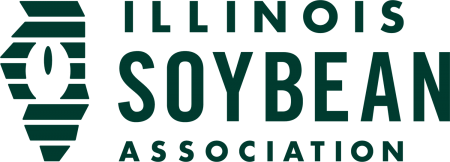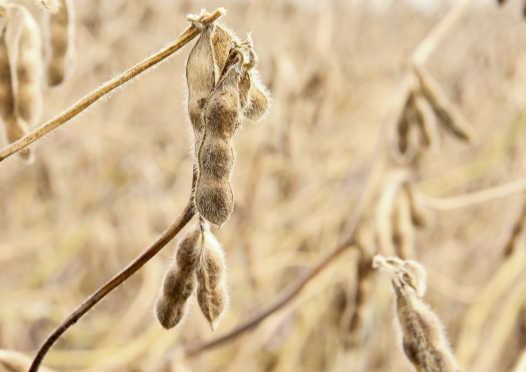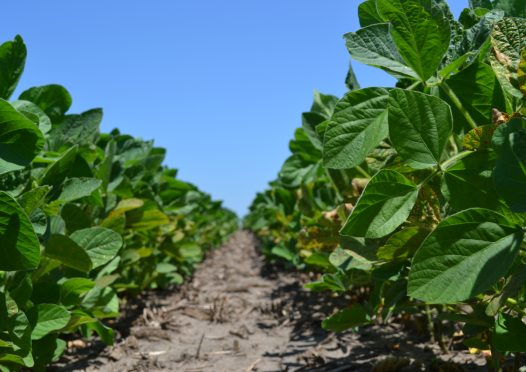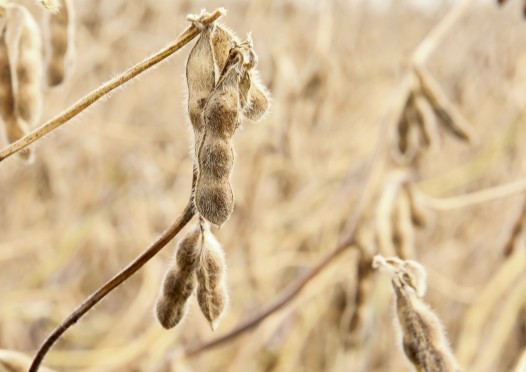ILSOYADVISOR POST
Agronomy: Behind the Scenes in the Drive to 108.3 Bushel Beans
Anyone who thought last year’s 104-bushel record soybean yield was a fluke may be eating crow as harvest results come in throughout the state. Champaign County farmer Jason Lakey and his father, Robert, have set a new verified state soybean yield record with an astonishing 108.3 bushel yield.
Lakey’s achievement was part of the ISA Yield Challenge, a checkoff-funded program established in 2010 to encourage on-farm research to evaluate different management practices that can increase yields and profits.
ILSoyAdvisor sat down with several of the key players in this accomplishment. Here’s a first look behind the scenes to reaching 108.3 bushels.
Jason Lakey, Champaign, Ill. Farmer
Your 2015 Yield Challenge plot set a new soybean yield record for Illinois. Can you tell us about your overall approach?
We’ve had success with our corn acres—we had the second highest corn yield in the state in 2014—but this was the first year we really started chasing big bean yields.
The initial prep work started right after last year’s harvest, but it was probably in February when we really started gearing up and finalizing our approach.
We started with premium genetics, in this case Asgrow AG4135 with a 4.1 maturity group, protected by fungicide and insecticide seed treatments and a seed inoculant. We went with 20-inch rows and a population of 145,000 seeds per acre.
After that, we used a combination of defensive approaches, offensive approaches and careful monitoring throughout the season, and that helped us push those yields as high as we could. We planned for mid-season aerial applications, foliar feeding and more intensive management overall to learn what beans can do.
What were some keys to your success?
Early planting is really key, as is using a good full-season bean variety, like 3.8 to 4.2. We want those plants to stay green as long as possible to maximize the yields, and full-season beans are important to making that happen. Of course, you can plant too early, but with the late April planting, we had good emergence established before the rains came.
We knew this field would have the best chance—it was in corn last year and has good tile drainage, which helped us through the heavy rains we had in June. Overall, we were pleasantly surprised with the results throughout the season, despite the challenges of being so wet in June and then so dry later in the summer.
Who helped with this achievement?
We had a really great team that helped make this all possible. This group worked closely throughout the season. We could not have done this alone, so this whole team deserves great credit.
- The Ehler Bros. team including David Ehler, Kris Ehler and Shelby Kaufman
- Jason Watson from StollerUSA
- Our local Asgrow District Sales Manager, Pat Conlin
- Chad Barnes with Illini FS
- Shawn Clapp and Bob Landis from Rosen's Inc.
Any parting thoughts?
We learned a lot this season. You have to take some chances and then see what can be applied to the rest of your farms.
Shelby Kaufman, Ehler Bros agronomist
You worked closely with Jason and Robert Lakey on their record-setting 108.3-bushel Yield Challenge plot. That’s an impressive yield. How did you accomplish it?
One really critical key is to choose the right variety and plant early to capture the most sunlight throughout the season; we want to maximize growth and set more pods to increase yields.
This plot was planted on April 23 in 20-inch rows in ideal conditions. We find planting dates around April 20 to 24 are key for the best growth.
Our trials include 15-, 20- and 30-inch rows. In this area, we’ve seen the 20-inch rows perform the best – this allows for more air movement early on, but still gives a good canopy close.
What about in-season management?
We scouted regularly, at least every two to three weeks. We were really looking closely at plant health for any issues throughout the season. We monitored plant height, counted the trifoliates and did pod counts, and adjusted our approach as needed. We used several different inputs to encourage growth and keep the plants happy and free of stress.
We saw the greatest response in the middle of the plant. Pod counts there really responded to what we were doing.
Was weather the biggest challenge?
Water was a big challenge for us as it was for most of the state. April and May weather was very good, but June got very wet—the plot location received 9.5 inches of rain in the month of June—then got dry again in July and August. Fortunately, things started to dry out right as we thought diseases would start to pop up, and a few well-timed late-season rains helped us push through the seed fill stage.
Any parting thoughts?
It takes a solid team to do this and really good, regular communication about plant development to make needed adjustments.
Jason Watson, StollerUSA
Tell us about the team approach used to reach 108 bushels.
First, the Lakey family has a long tradition of pushing boundaries and trying new things to improve their operations—it’s just part of their philosophy. They were great to work with and we’re very proud of their success. It takes a whole team, and we were lucky to have a great group of people.
Much of the day-to-day legwork was done with the team at Ehler Bros. They are very hands-on and deliver the ongoing face-to-face service that a regional sales rep like myself can’t always do. We worked very closely throughout the season and had a good tag-team system in place with scouting and making decisions about how to manage that field.
Start by giving us the big picture – what was your overall approach with Lakey’s Yield Challenge plot?
Our overall approach is always to start with high-yield genetics for your situation and from your preferred company, and then do everything we can to help maximize that genetic potential throughout the season. We want to manage stresses and keep those plants healthy and happy. That gives them their best chance to maximize their productive capacity.
We had an aggressive management plan in place, but there’s so much variability from field to field, from soil health to weather and pest pressures, so a one-size-fits-all approach will not be as effective. You need to adjust on the fly based on what the plants are showing you.
We did regular scouting throughout the season. We checked nodulation and watched plant growth; we diagramed the plants to note the nodes, stalk size and branching. This helped us respond to changing conditions and plant needs.
What differed in Lakey’s Yield Challenge plot vs. a more standard management approach?
From the start, the team did everything we could to maximize the yield potential. We planted early and used good fertility along with seed treatments.
Most soybean crops will usually get one or two in-season sprays, certainly weed control early and sometimes fungicides and/or insecticides around R3 stage. We always try to time our additional treatments with a planned spray wherever possible.
We added a foliar nutritional spray, Bio-Forge®, along with a fungicide and insecticide spray about two weeks after the glyphosate application. We also included Bio-Forge® with the fungicide and insecticide sprays at R2 to R3 to help promote flowering and vegetative growth. We came back with more foliar nutrition, Sugar MoverTM at R5 to help stimulate pod fill. We know that bigger seeds lead to bigger yields, and this stage is where the plant is most hungry, just like an expecting mother.
In additional to various foliar inputs, we also employed NDVI* imagery and other new technologies to help identify the best areas of the field and refine our approach throughout the season.
*NDVI=normalized difference vegetation index
Any parting thoughts?
Ultimately, programs like the soybean ISA Yield Challenge are important learning opportunities. The innovative and progressive farmers, like the Lakeys, improve their operations through these on-farm trials. It’s important to learn what works best for your fields, but it also helps all Illinois soybean farmers better understand what drives yields. I tell the growers I work with they should try to learn at least one thing each year and to keep striving for continued improvement.
Especially in rough seasons, whether wet seasons like 2015 or dry years like 2012, soybeans show more resilience than corn. And soybean yields have even more potential for gains and opportunities for better management. Other farmers I’m working with see consistent yields in the mid- to upper-80 bushel-per-acre range, so results like this are not isolated.
Every farmer needs to experiment and find out what’s right for them. A better understanding will help them make the right adjustments.
Don Meyer, ISU, Yield Challenge coordinator
You and your team are collecting and analyzing the Yield Challenge data. As results come in, what can you tell us about this year’s program?
Participation overall was down slightly from last year, probably because of lower commodity prices, but we had about 50 to 55 Yield Challenge participants, and about half of those were also gunning for the 100-Bushel Challenge.
We’ll have more complete results, including regional and state winners, to share by January.
Do you have initial results to share?
Overall, we’re seeing some tremendous numbers. The 108.3 was almost off the charts, but we’ve also seen many farmers in the 80- and even 90-bushel-per-acre ranges. At least half of those going for 100 bushels were in the 85-plus bushel range.
It’s just great to see so many farmers reaching those yield levels. It really helps illustrate a positive use of checkoff funds and verifies what ISA has been saying for the last few years – that management matters for beans just like it does for corn, and paying attention to your beans can really make a difference.
What are your next steps?
Short term, we need to collect the remaining data. All participants complete a simple two-page form about their management practices and the inputs they used. Much of this is still coming in, but we’re already starting on the analysis portion, which is where we hope to see some commonalities between those high-yield acres.
We hope to gain a better idea about what does and doesn’t help to really push those high yields, which practices offer the most consistent results and offer the biggest bang for the buck.
Ultimately, we hope to learn better ways to help all Illinois soybean farmers be more successful and more profitable.
Any parting thoughts?
We have four undergrads and graduate students crunching the numbers. The ISA Yield Challenge is a great experience for them. It’s a fun project, but most importantly, it helps them start to apply their academic knowledge with a real-world project. It’s a great experience as they move out of college and into professional careers.





Comments
Add new comment